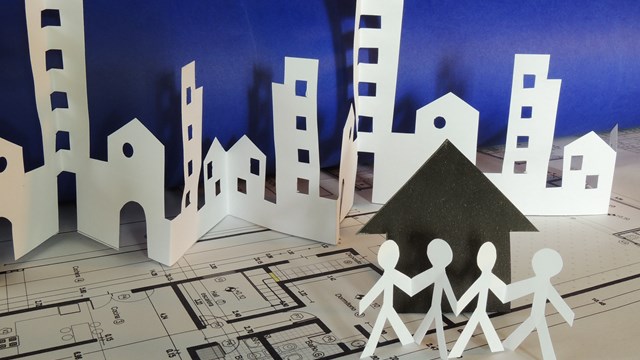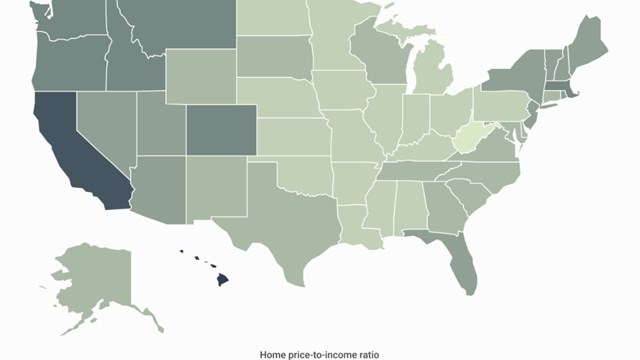Housing affordability – or unaffordability, depending on your relative net worth – has always been a hot topic in New York City. Today’s housing market is no different – though in recent years, thanks to a combination of factors both economic and political, the chronic nature of the problem has become more acute. As income inequality has increased and public policy has swung toward providing housing opportunities almost exclusively through the private sector, the availability of adequate, affordable housing for anyone but the elite has become increasingly scarce.
A Brief Look Back
The conflict between different approaches to both the development and promotion of affordable housing in New York City, as well as to urban planning in general, goes back decades, even centuries, in the city’s history. In the mid-nineteenth century, the clearing of the Five Points, a notorious slum in lower Manhattan that’s now occupied by courthouses and other governmental buildings, was an early example of the city government’s attempts to redesign urban space. Like the grand plans that created the current configurations of European capitals like Paris and Berlin, the destruction of the Five Points slum was undertaken to make it easier to police the restive local population.
For much of the first half of the 20th century, and really into the 1960s, affordable housing development fell squarely in the realm of large-scale, publicly created and funded projects; properties such as Stuyvesant Town in Manhattan, Co-op City in the Bronx, and even the development of Lincoln Center are examples. Public housing was exactly what it sounded like – housing conceived of and funded by the government, or sometimes by unions, for the working and middle classes.
These projects often involved massive urban ‘renewal,’ which in many cases was code for the wiping out of existing neighborhoods to be replaced by ‘neighborhoods of the future.’ The social upheaval caused by this approach came to a head in the 1960s when journalist-activist Jane Jacobs, an advocate for preserving the existing urban fabric, battled urban planning titan Robert Moses over the construction of an expressway that would have wiped out large segments of Manhattan’s Greenwich Village. Ultimately, Jacobs’ vision won out and the grand (some might say grandiose) projects so often associated with Robert Moses lost favor.
After New York City’s financial default in the mid-1970s, and the convulsions the city faced as a result of shifting populations and trends, the approach to developing affordable housing for both the working and middle classes changed. Rather than the publicly directed and funded projects of the past, the private sector was provided the opportunity to supply housing at all levels, with government assistance coming through tax policy. Public bonds for construction were replaced with various tax incentives to promote all levels of housing construction. Whether or not that approach – which is still in favor today – has in fact produced the desired result of more housing being attainable by more people is debatable. Either way, growing populations, changing economics, and other complex issues raise the question of how New York City will navigate its seemingly perpetual housing struggles going forward.
Private Sector, Public Support
The premise underlying the current approach to affordable housing development is the idea that the market is more efficient than the public sector, and will do a better job at providing what’s needed at all levels with indirect public support. That support comes in the form of tax incentive programs like 421-A (which encourages development of underused/underutilized land) and J-51 (which is granted for buildings planning renovations). In return, the private sector implicitly agrees to provide a certain percentage of affordable units in mixed developments through the use of mandatory inclusionary housing (MIH). Perhaps the most easily recognizable manifestation of MIH to most New Yorkers is the ‘80/20’ building, meaning a newly built property where 80% of the units are rented or sold at market rate, and the remaining 20% are subsidized, rented or sold for a discounted price to residents who meet certain income and asset restrictions to qualify.
The upside of this approach has been that those who could otherwise never afford it can now access new, quality housing. The downside is that according to just about everyone who watches these trends, the number of units provided has been wholly insufficient in relation to the need – and the mixed-income model has resulted in such socially awkward phenomena as separate building entrances for lower-income residents, sometimes referred to as ‘poor doors.’ These projects are usually paired with ‘up-zoning’ – rezoning areas to provide for denser construction – which almost inevitably leads to the displacement of long-time residents who find themselves priced out of the neighborhoods they may have lived in for generations.
Matthew Lasner is an associate professor of urban planning at Hunter College in Manhattan. His recommendation for the future is to continue the present system of MIH, but to expand and build on it. “I would recommend an expansion of MIH, but universally, rather than in just up-zoned areas. Universal MIH would specify that in any new building over a specified size or number of units – for mid-rise buildings and up – [developers] would be required to include a certain percentage of below-market units.” Lasner says this would apply to both rental and for-sale construction. “The reason we need this is because affordable housing is the responsibility of everyone. The best way to ensure that we all share that burden is through public spending – but the states, and in particular the federal government, have not shown any interest in providing affordable housing for decades through tax-and-spend type programs. We can approximate that better than we are doing now by requiring that every building in every neighborhood include MIH, without the displacement sideshow caused by up-zoning.”
Lasner is also in favor of a voucher program to augment MIH. “A more vibrant city or state voucher program could be used. It’s out of favor right now, but is being discussed in California. This program would balance the production of new units while allowing people to have more choices and more access to privately owned housing units.” Voucher systems could be used for both rental and owned housing in the form of assistance with down payments.
Grand Gestures
Another approach to providing sustainable, affordable housing is to return to the publicly planned and funded approach used before the 1970s. Robert Snyder is a professor of urban history at Rutgers University-Newark and will soon become the City Historian for New York City. “For New York and other cities,” he says, “to become more affordable, city governments have to gain strong allies and supporters beyond their borders. That involves not only state legislatures, but also the federal government to help create affordable housing.” Snyder points to the Mitchell-Lama program as a vehicle designed to keep the middle class in New York City. He suggests that an updated version of this is needed today. “Solutions provided within the free market don’t work,” he says. “The free market doesn’t produce affordable housing on its own.”
Snyder also suggests that any large-scale public projects to provide affordable housing in both the rental and ownership markets must be combined with infrastructure improvements in transportation. Available land for such projects is found today in the farther reaches of our urban environment – but affordable, reliable, accessible transportation systems to bring residents of these projects would have to be built to make them viable. According to Snyder, the time for the ‘Grand Plan’ has passed. The new Hudson Yards development on Manhattan’s west side, for example, is a grand plan built by the private sector almost exclusively for the rich. “You have to begin with a plan that builds in affordability as a priority,” he says, “not as a side benefit of development, that’s the challenge.” That said, Snyder says he does believe that New York has another opportunity to ‘do it right’ if the Sunnyside Yards in Queens are redeveloped.
David Eisenbach, a professor of history at Columbia University, makes similar points. “A grand scale type project would be more equitable,” he says, “but we abandoned this approach years ago. Even liberal politicians don’t buy into it today.” Eisenbach reflects that “Historically, a change in direction for public policy requires two things to happen simultaneously: a sustained political shift, and a crash in the real estate market.” Those events occurred in the late 1970s and early 80s when we saw a shift from public planning to free market development. The New York real estate market crashed in the late 70s, and unconstrained confidence in free markets under the Reagan administration became a dominant political force in the early 80s – and Eisenbach thinks we may be at that crossroads again. There are signs that the real estate market is in trouble, with tremendous overbuilding of luxury units that have yet to be absorbed, and the distinct possibility of a political shift to the left – a phenomenon that would be judged by two election cycles. The first – 2018 – is over. The election of 2020 may well tell.
Mitchell-Lama 2.0
Dr. Adam Tanaka is a senior analyst with HR&A Advisors, an urban planning advisory based in New York City. He is a proponent of taking a new look at a more middle-of-the-road approach that could be viewed as a ‘Mitchell-Lama 2.0.’ The Mitchell-Lama program was a housing program enacted in 1955 across New York State to provide affordable, middle-class housing. The program was particularly successful in New York City, where it provided much needed multi family housing in many neighborhoods, enabling working New Yorkers – teachers, firefighters, city workers, and other middle-income residents – to live closer to their workplaces and contribute more directly to the economies of their neighborhoods.
“A number of factors led to New York City and New York State investing in housing for middle-income people,” says Tanaka. “One was the power of organized labor, which sustained itself longer in New York City than in other places, particularly in the garment and electrical unions in the 1950s and 60s as a matter of economic survival. Many of the projects built then were both sponsored and financed by these unions. Another factor was that New York City was more progressive, so this approach was ideologically palatable. The middle classes in New York City were also better acclimated to apartment living, which is not typical elsewhere. The approach in New York City was more comparable to the approach employed in Western Europe vis-a-vis the middle class.” Examples of these projects include Rochdale Village in Queens, Co-op City in the Bronx, and Penn South in Manhattan, among others.
A sterling example of the effectiveness of Mitchell-Lama type development might be the single-building approach employed as part of the Upper West Side Urban Renewal District in Manhattan. The district, which is bounded by 72nd Street on the south, 96th Street on the north, Central Park West on the east and Amsterdam Avenue on the west, is home to many Mitchell-Lama buildings which served as anchors to the redevelopment of the entire district, a renewal scheme that included both private and public investment for projects large and small. The neighborhood – now one of the most desirable in New York City – features middle-income Mitchell-Lama co-ops, privately owned apartment buildings, renovated townhouses, and luxury developments.
Can a Mitchell-Lama 2.0 happen? “With the Federal government offering very little assistance,” says Tanaka, “it makes it very difficult. In the Mitchell-Lama era, cities didn’t worry about where funding came from. Today, we are in a different environment. Federal programs are decimated. Cities need to think carefully about who are the vested interests in their economies. Those are the major employers in those cities, and other institutions like hospitals and universities, as well as large developers and landowners who are interested in economic vibrancy. If a city becomes too expensive, the base will shrink.”
Robert Snyder makes a similar observation. He contemplates that as New York becomes increasingly more expensive, young people who would otherwise come to New York to start their lives and careers – and in so doing contribute and uphold the city’s status as a place where not only money is made, but culture is created and innovations are born – will choose other places to live and work if New York is too expensive to allow them a reasonable standard and quality of life.
In the end, Tanaka suggests, a Mitchell-Lama 2.0 approach is a challenge. “It’s a political question. Allocating money to the middle class is a challenge. It’s a trade off with respect to the very poor, the neediest.” With that thought in mind, the ultimate question about creating a more affordable future New York may be, ‘Affordable for who?’
A J Sidransky is a staff writer/reporter for The Cooperator, and a published novelist.










Comments
Leave a Comment